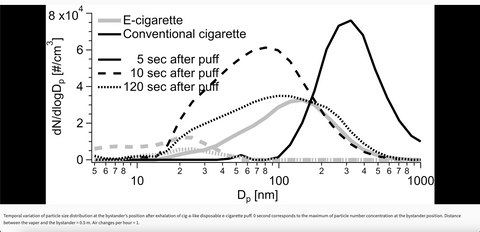
How long does vape smoke stay in the air?
Vape smoke, or vapor, is less dense than traditional cigarette smoke and consists mainly of propylene glycol, glycerine, and flavorings. In essence, vape smoke from e-cigarettes dissipates rapidly in the air, usually within 10 to 15 seconds after exhalation, due to the evaporation of liquid droplets. This composition, along with environmental factors, influences how long vape smoke stays visible in the air:
- Density of Vapor: Vape smoke is lighter and less dense, allowing it to disperse more quickly than cigarette smoke.
- Room Ventilation: Adequate ventilation significantly reduces the time vape smoke remains visible, promoting rapid dispersion.
- Humidity Levels: Higher humidity facilitates faster vapor dispersion by causing the particles to settle more quickly.
- Temperature: Warmer temperatures encourage faster dissipation of vape smoke, reducing its visibility duration.
This quick dissipation, combined with the low chemical release, suggests minimal impact on ambient air quality, especially in comparison to the more stable and longer-lasting particles from conventional cigarettes.
Does Vaping Inside Stain Walls?
Vaping can leave a residue on walls, particularly from e-liquids with high vegetable glycerin content. This residue can attract dirt and potentially cause staining over time. However, compared to cigarette smoke, the impact is less severe and can be managed with regular cleaning and proper ventilation.
Will Vaping Inside Leave a Long-Lasting Smell?
Vaping indoors may leave a faint smell, but it is significantly less pervasive and long-lasting than the smell from traditional cigarettes. Good ventilation can help remove any lingering odors more effectively. The duration and intensity of the smell depend on factors like the type of e-liquid used, the frequency of vaping, and the level of indoor ventilation.
How Long Does Vape Smell Linger in a Room?
The smell of vape can vary in how long it lingers, from a few seconds to several minutes, and potentially longer in poorly ventilated spaces. Factors influencing this include the ventilation level, the frequency of vaping, and the potency of the e-liquid flavors used.
Understanding Vape Smoke: Composition, Dissipation, and Air Quality Impact
-
Vape Smoke Composition: Vape smoke, or aerosols, primarily consists of liquid droplets formed from propylene glycol, glycerol, and water. These aerosols are significantly different from traditional cigarette smoke, which contains solid particles from combustion.
-
Dissipation Rate: The aerosols from e-cigarettes evaporate at a much faster rate than smoke from conventional cigarettes. Studies have shown that these aerosols have a short half-life in ambient air, disappearing around 10–15 seconds after being exhaled. This rapid dissipation is attributed to the quick evaporation of the liquid droplets at room temperature.
-
Influence of Environmental Factors: The study also discusses how several factors, such as the generation of the vaping device, ventilation patterns, and environmental conditions (e.g., temperature and humidity), can influence the behavior of exhaled aerosols.
-
Impact on Air Quality: Compared to conventional cigarettes, the aerosols from e-cigarettes release very low levels of chemicals into the ambient air and are unlikely to pose significant issues to bystanders based on regulatory indoor air quality standards.
-
Dynamic Properties of Aerosols: The research underscores a need for further understanding of the dynamic properties of e-cigarette aerosols, especially in real-world environments with varying environmental conditions.
Comparing Air Quality Impact: E-Cigarette Vapor vs. Traditional Cigarette Smoke
A 2018 study led by Dainius Martuzevicius and his team, published in "Nicotine & Tobacco Research," looked into how the mist from e-cigarettes and smoke from traditional cigarettes spread out in the air and how long they stay there. They were especially interested in comparing the two to see which one might be less bothersome or harmful to people nearby who aren't smoking or vaping themselves.
A breakdown of what they found:
-
E-Cigarettes vs. Traditional Cigarettes: The big difference between the two is that e-cigarettes don't use tobacco and don't create smoke the way burning a traditional cigarette does. Instead, e-cigarettes produce a kind of mist or vapor.
-
How They Did the Study: They asked people to either vape or smoke in a special room set up to mimic a real indoor environment. They also used a heated mannequin to represent a person standing nearby, to see how much of the smoke or vapor would reach a bystander. They changed things up by having smokers and vapers at different distances from the mannequin and adjusting how much air was moving around in the room.
-
What They Found About the Smoke and Vapor:
- Right after taking a puff, the amount of stuff in the air was pretty much the same for both e-cigarettes and regular cigarettes.
- But, the vapor from e-cigarettes disappeared quickly, going back to normal air levels in just a few seconds.
- Smoke from regular cigarettes didn’t clear out nearly as fast. It took 30–45 minutes to go back to normal, especially if the room wasn't well-ventilated.
- The tiny droplets that make up e-cigarette vapor are smaller than the particles in cigarette smoke, and they evaporate almost as soon as they're exhaled. This means they don't stick around in the air as long, the 2018 study suggests that e-cigarette vapor is less intrusive and potentially less harmful to bystanders than traditional cigarette smoke, mainly because it evaporates much faster and doesn't stay in the air as long.

Figure by Nicotine & Tobacco Research, Volume 21, Issue 10, October 2019, Pages 1371–1377, Distance between the vaper and the bystander = 0.5 m. Air changes per hour = 1
How the size of vapor particles changes over time near someone standing close by after a puff is taken from a disposable e-cigarette. Right when the puff is exhaled, that's when there are the most particles in the air near the bystander. The person vaping and the bystander are half a meter apart. The room's air is refreshed once
- What This Means: The study shows that the mist from e-cigarettes doesn't hang in the air as long as smoke from traditional cigarettes. For e-cigarettes, the vapor quickly turns back into air, which means it's less likely to bother or harm people nearby. On the other hand, smoke from traditional cigarettes can linger for a long time, especially in places without good airflow.
Can you get second hand smoke from vaping?
Key Factors Affecting Vape Smoke Dissipation in the Air

Leave a comment